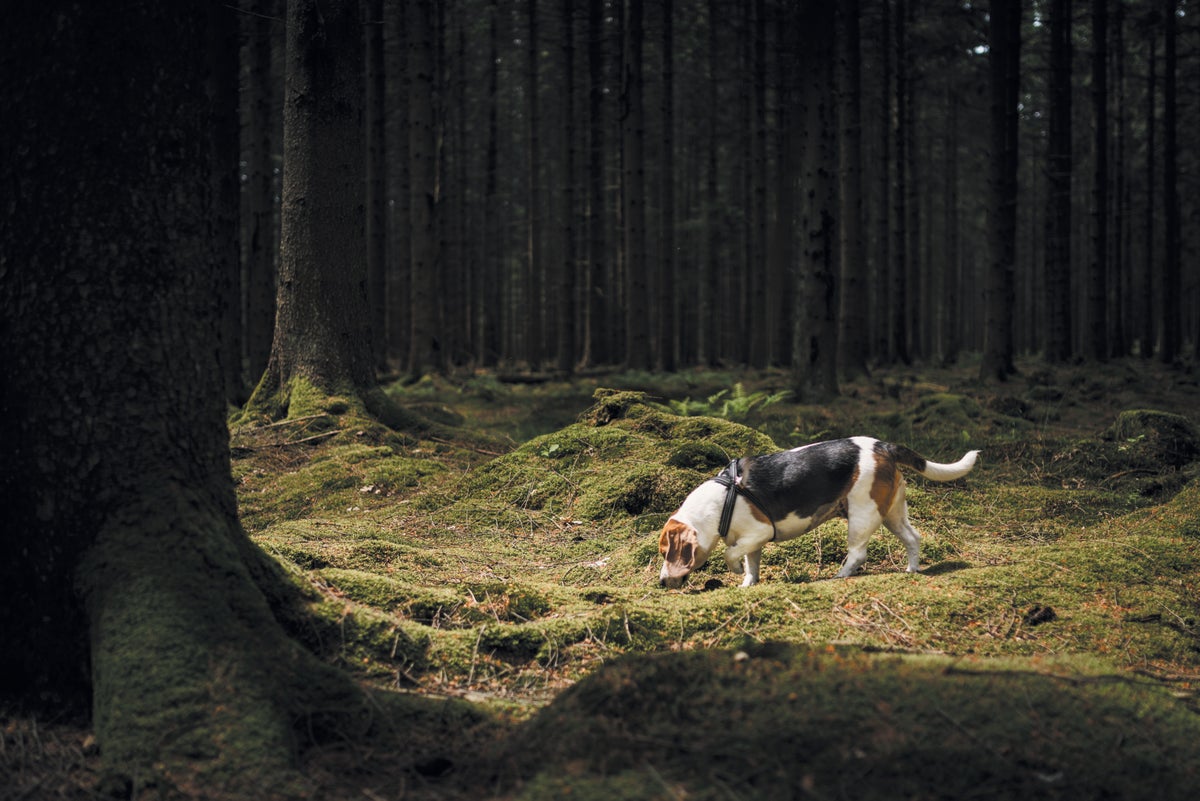Pessimistic Dogs Are Better at Smelling Cancer—And Other Keys to Disease-Sniffing Success
New research is revealing how disease-smelling dogs can excel
Individual dogs’ personalities, and how we interpret their behaviors, may be key to disease sniffing at scale.
Billy, a floppy-eared little beagle, darts around a platform sniffing a series of holes. Each hole contains a used surgical-type mask bearing a different human’s distinct mix of scents. But her sharp nose is hunting for just one such combination: the one that signals cancer.
Cancer can change a person’s “volatilome,” the unique set of volatile organic compounds found in breath, sweat, blood and urine. Billy and her cohort have learned to sniff out these subtle scent cues in masks worn by people with cancer diagnoses. Researchers are also studying how dogs can detect diseases such as COVID and malaria, as well as psychological conditions, including post-traumatic stress disorder.
Scientists discovered dogs’ powerful disease-smelling skills in 1989, when a dog detected cancer in its handler. But clinicians still do not routinely use dogs for diagnosis. Besides the obvious logistical challenges, dogs vary greatly in their olfactory accuracy. Researchers are increasingly finding that disease-sniffing prowess may come down to individual dogs’ personality—and how well their handlers know them. New research efforts are focused on figuring out which dogs would be best for the job and on interpreting dogs’ behaviors during a smell test.
If you’re enjoying this article, consider supporting our award-winning journalism by subscribing. By purchasing a subscription you are helping to ensure the future of impactful stories about the discoveries and ideas shaping our world today.
Sharyn Bistre Dabbah, a veterinary scientist now at the University of Bristol in England, set out with colleagues at the U.K. charity Medical Detection Dogs to learn how the animals’ personalities—especially their level of optimism or pessimism—affect disease-detection skills. Their results appeared recently in PLoS One.
The researchers first showed the dogs what lay behind two screens at one end of a room: a “positive” location with a tasty treat and a “negative” one with an empty bowl. On subsequent visits to the room, the dogs typically bounded happily toward the former but trotted very slowly when they went to check out the latter—or simply didn’t go there at all.
The scientists then placed bowls behind two new screens between the positive and negative spots, and they classified the dogs as “optimistic” or “pessimistic” based on how quickly they investigated these new locations.
Next, the team evaluated how accurately each dog could pick out a disease scent it was trained to detect among other smells. On average, the pessimistic dogs turned out to be more discerning. Pessimistic dogs are more cautious, and “a more cautious dog might be better at not making mistakes,” Dabbah says.
Other personality traits also play a role, says Clara Wilson, who researches disease- and stress-sniffing dogs at the University of Pennsylvania. Dogs that enjoy the thrill of a hunt—and thrive while searching for missing people or hidden bombs—might find sniffing through disease samples again and again rather repetitive. “We want a dog that doesn’t get frustrated. They [should] find it rewarding, even though it may be less exciting,” Wilson explains.
Handlers’ interpretations of dog behavior can also skew detection outcomes, says Akash Kulgod, co-founder of Dognosis, the Bengaluru-based start-up that trained Billy. Instead of teaching dogs to perform a specific behavior such as sitting or barking when they pick up an assigned scent—a process that takes extra time and can lead to dogs “lying” for treats—Kulgod and his team directly analyze each dog’s natural body language. Based on how confidently the dogs move, as analyzed with computer vision–based machine-learning tools, the team can spot successful detections. “One of our dogs sniffs and then very confidently somersaults to go to the feeder,” Kulgod says. “They each have their own unique quirks—but all of it can be quantified because it’s all related to this reward expectation that you have from the past sessions.”
Doctors currently diagnose many kinds of cancers by using a combination of blood tests and biopsies. Researchers are always on the lookout for less invasive methods—including options directly involving our canine companions, as well as electronic noses inspired by them. Dogs can currently outperform electronic sniffers. But this primacy may not last, according to Andreas Mershin, chief science officer at the Boston-based start-up RealNose.ai. He and his colleagues are developing electronic noses to sniff urine samples for prostate cancer and other diseases. If machine olfaction eventually surpasses dogs’ abilities, it could help tackle the scalability problem—and give the animals a break.
Mershin’s team put mammalian smell receptors on an electronic chip and used machine-learning algorithms to interpret the output. The technique focuses on broader patterns among detected molecules rather than categorizing them individually.
In a study published in PLoS One, Mershin and his team used machine-learning models to spot and analyze patterns of different odorants in urine samples from confirmed prostate cancer patients. Their findings, which built on work with diagnosis data from Medical Detection Dogs, suggest that focusing on this type of “scent character” might work as a scalable alternative to dogs, even if it’s currently much slower.
Source: www.scientificamerican.com
